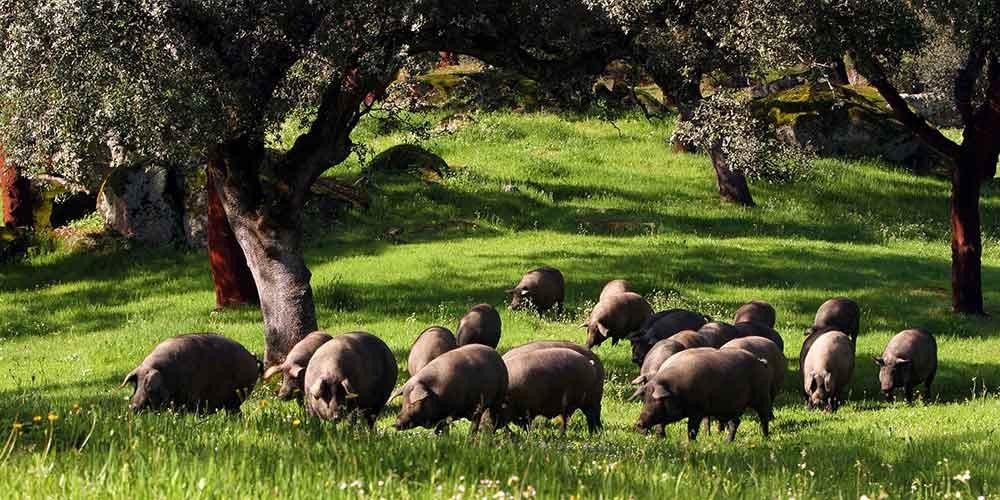
Ibérico Ham - Taste The Difference!
Love Ibérico ham? Then read this great blog from Provender Brown to find out how to separate your bellota from your cebo!


Love Ibérico ham? Then read this great blog from Provender Brown to find out how to separate your bellota from your cebo!
According to Dr. Emilio Grande Covián, founder of the Spanish Nutrition Society, “an acorn fed pig is an olive tree with legs”. I just love that description, which I think sums up the health benefits of Iberico de Bellota products beautifully. In my own house, it’s now known as “Sacred Ham”, following an outburst on discovering the kids devouring my stash a few years back! I’m sure many of our customers will have come across Ibérico ham (jamón ibérico) but I wonder how many understand what it is and how it differs from Serrano ham. Throw into the mix various different grades, cuts and finished products and it all becomes rather confusing so read on to find out what makes it so healthy and how to separate your bellota from your cebo.
There are two basic types of air dried ham produced in Spain – Serrano and Iberico. Serrano means ‘mountain ham’ and comes from white-skinned, domesticated pig breeds. It is meatier, generally less complex and firmer in texture than Ibérico ham. Serrano includes a number of different types of ham – the one we stock is Jamon de Teruel, which has its own Protected Designation of Origin (PDO) and in fact, was the first ham in Spain to do so.
Ibérico ham (you might also hear it referred to as 'pata negra') comes from Iberian pigs that generally have dark or reddish skins, black hooves and are descended from the wild boars of the Iberian Peninsula. Location, butchering and salting are important but the breed and diet are the most significant factors when producing great Ibérico ham – the breed determines whether or not it is Iberico; the diet determines the grade. This diagram summarises it quite nicely.
So the top grade is Iberico de Bellota and that’s what I’m going to concentrate on here.
Bellota simply means acorn in Spanish. To be labelled ‘jamón de bellota Ibérico’, the pig from which the meat derives must have ranged freely in the oak woods of the dehesa of south west Spain and eaten nothing but acorns and wild grasses for the last 10-12 weeks of its life, although many of the animals will have been raised outdoors throughout their lives. Pigs used to make jamón de bellota ibérico will be at least 14 months old before they are slaughtered. The hams can then spend up to 5 years curing. This means it may be more than 6 years from birth to finished ham. That, plus the labour intensive production methods and the limited supply of acorns, explains why Iberico de bellota products have such a hefty price tag.
Iberico pigs are an integral element of the environment of the Dehesa. This huge area of gently rolling, wooded country, growing, almost exclusively, varieties of oak trees, has been managed by man for thousands of years. Throughout this time a vital balance has been struck in the use of the region’s resources; crop growing, tree management and animal rearing. The resulting eco-system is now one of the most important in Europe, home to enormous bio-diversity and some of the continent’s most endangered species.
Jamón de bellota ibérico (acorn fed ibérico ham), not only tastes delicious, but is the source of many health enhancing vitamins and minerals. The fat of acorn fed ibérico pigs contains over 55% oleic acid, which is also present in olive oil. This stimulates the production of High Density Lipoproteins (good cholesterol), and reduces Low Density Lipoproteins, so helping to prevent heart disease. It is also rich in B vitamins (including riboflavin, thiamine and folic acid), as well as the powerfully antioxidant vitamin E.
It contains minerals crucial for physical development such as iron, zinc, magnesium and selenium, important for healthy bone growth, the functioning of the thyroid and in speeding up healing after injury, amongst other benefits. Acorn fed ibérico ham contains 50% more protein than fresh meat, and only 300-350 kcal for a 100g serving, making it, in moderation, an enjoyable and healthy part of a diet.
Of course being good for us and good for the environment is all very well but those factors alone are not going to find Iberico products a place in the counters of Provender Brown! What matters most to us is that these products also taste amazing. Great ‘jamón de bellota Ibérico’ has an exceptional and distinctive taste. It is floral, juicy, earthy, savoury and nutty, with rich, well-marbled fat that melts in the mouth. It has the same incredible intensity of flavour of a great cheese or wine. In the words of Simon Majumdar in The Guardian, it is “arguably the greatest item of food in the world.” Now that, on the other hand, will win it a place!
The ideal pairing for an acorn-fed ham is a glass of chilled Fino sherry, a vintage champagne or a medium bodied red wine. Our Wine of the Month, Pieropan 'Ruberpan' Valpolicella Superiore would be perfect.
Of course, the hams themselves are only the hind legs of the pigs; all the other cuts are also used to make a variety of products. Salchichon (salami), chorizo, lomo (cured pork loin), sobrasada (spreadable chorizo) and fresh pork meat can all be found in both Iberico and non-Iberico forms. If “Iberico” doesn’t appear in the name then it’s safe to assume it will be made from white-skinned pigs.
With thanks and acknowledgement to Dr. Emilio Grande Covián, Founder of the Spanish Nutrition Society

Discover Our 2025 Christmas Hampers
Still available for shop collection and local delivery 🎄